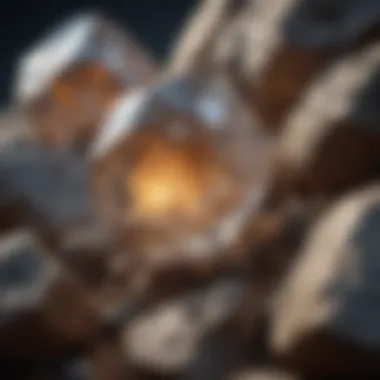A Comprehensive Guide to Identifying Minerals in Rocks - Expert Techniques Revealed


Rock and Fossil Identification
Identifying minerals in rocks involves a meticulous examination of various types of rocks and fossils. From sedimentary rocks like sandstone to metamorphic ones such as marble, each type possesses distinctive characteristics that aid in accurate identification. Fossils, preserved remains of ancient organisms, offer valuable insights into past life forms. When identifying minerals, keen observation is key, focusing on physical properties like color, luster, hardness, and crystal form. Utilizing specialized tools like magnifying lenses, streak plates, and UV lights further enhances the identification process, enabling collectors to delve deeper into the mysteries of rocks and fossils.
Types of rocks and fossils
Rocks come in an array of forms, including igneous, sedimentary, and metamorphic rocks, each with unique mineral compositions. Igneous rocks like granite form from molten lava, showcasing interlocking crystals. Sedimentary rocks like limestone derive from organic or inorganic sediments, presenting layered structures. Metamorphic rocks such as schist undergo intense heat and pressure, resulting in banding and foliation patterns. Fossils, on the other hand, vary from petrified bones to imprints of ancient plants, serving as crucial indicators of bygone ages.
Characteristics to look for
In the realm of mineral identification, several essential characteristics set minerals apart. Color, though versatile, can be influenced by impurities. Luster, defined by the way light reflects off a mineral's surface, ranges from metallic to pearly. Hardness, measured on the Mohs scale, determines a mineral's resistance to scratching. Additionally, crystal form, cleavage, and streak color provide further clues to differentiate minerals, aiding collectors in their quest to unravel the secrets held within rocks and fossils.
Tools for identification
Accurate mineral identification often relies on a variety of tools tailored to unveil hidden features. A handheld magnifying loupe serves to inspect minute details like crystal faces and cleavage planes. Streak plates assist in determining a mineral's powder color, a characteristic unaffected by impurities. UV lights reveal fluorescence in certain minerals, aiding in their recognition. By leveraging these tools meticulously, collectors can discern the nuances of rocks and fossils, enriching their understanding of the Earth's intricate geological makeup.
Introduction
As we embark on the journey of understanding mineral identification within rocks, we delve into a realm of paramount importance for geological enthusiasts. This pivotal topic serves as the cornerstone for uncovering the mysteries encapsulated within rocks and fossils. By comprehensively exploring the various techniques, characteristics, and tools essential for mineral identification, we aim to equip rock and fossil collectors of all levels with the necessary knowledge to decipher the secrets hidden in the Earth's crust.
Understanding Mineral Identification
Definition of Minerals in Rocks
The essence of mineral identification lies in discerning the unique composition and structure of minerals embedded in rocks. Understanding the definition of minerals in rocks provides a fundamental framework for deciphering their properties and origins. By grasping the intricacies of mineral composition within rocks, we can unravel the geological history encapsulated in each specimen, enriching our exploration of the Earth's past.
Importance of Mineral Identificatio
The significance of mineral identification extends beyond mere categorization; it enables us to draw valuable insights into geological processes and historical contexts. By accurately identifying minerals within rocks, we unlock a treasure trove of information vital for piecing together the puzzle of Earth's evolution. This meticulous scrutiny not only aids in scientific research but also enhances our appreciation for the intricate tapestry of minerals that make up our planet's foundation.
Significance in Geology


Delving into the significance of mineral identification in geology opens a portal to understanding the underlying forces that have shaped the Earth's surface. By studying minerals in rocks, geologists can decipher the geological events that have left their mark on the landscape. This profound insight into the Earth's history enables us to trace the footsteps of time and decode the complex interactions that have sculpted the world around us.
Overview of Mineral Characteristics
Color and Streak
The examination of color and streak in minerals illuminates crucial clues essential for their identification. By discerning the distinct hues and streak patterns, we can pinpoint key characteristics that differentiate one mineral from another. This meticulous analysis not only aids in classification but also offers a glimpse into the intricate vibrancy hidden within the Earth's rocky tapestry.
Crystal Form and Habit
Exploring crystal form and habit unveils the intricate beauty inherent in mineral structures. By studying the geometric arrangements of crystals and their growth patterns, we gain a deeper appreciation for the underlying symmetry of the mineral world. This keen observation not only enhances our understanding of mineral composition but also showcases the remarkable diversity present in nature's crystalline creations.
Cleavage and Fracture
Investigating the cleavage and fracture properties of minerals provides invaluable insights into their internal structures. By examining how minerals break along specific planes or irregular surfaces, we can decipher their internal cohesion and molecular arrangements. This meticulous analysis not only aids in mineral identification but also sheds light on the forces that have shaped these crystalline entities over millennia.
Tools for Mineral Identification
Hand Lens and Magnifying Glass
The utilization of hand lenses and magnifying glasses enhances the precision of mineral identification by offering a closer look at mineral features. By magnifying intricate details and surface textures, these tools aid in distinguishing subtle differences crucial for accurate classification. This visual enhancement not only sharpens our observational skills but also enriches the mineral identification process with a deeper level of scrutiny.
Geologist's Hammer
The geologist's hammer serves as a versatile tool indispensable for extracting mineral samples from rocks. By employing the hammer's sturdy build and precise striking capabilities, geologists can extract specimens for closer examination and analysis. This hands-on approach not only facilitates fieldwork but also enables researchers to collect vital data essential for unraveling the mysteries concealed within mineral-rich rocks.
Streak Plate and Magnet
The streak plate and magnet are indispensable tools for conducting quick tests to determine key properties of minerals. By observing the streak color left by a mineral on a streak plate or testing for magnetic properties, geologists can swiftly narrow down potential mineral identities. These rapid diagnostic tools not only streamline the identification process but also offer a practical and efficient means of classifying minerals in the field.
Physical Properties


In this section of the article, we delve into the critical aspects of Physical Properties and their significance in the identification of minerals in rocks. Understanding the physical properties of minerals is fundamental as it provides valuable insights into their composition and characteristics. By examining properties such as color, streak, hardness, density, and others, geologists and rock collectors can differentiate between various minerals and rocks with precision. Moreover, recognizing these physical properties aids in determining the geological history and formation processes of rocks, offering a deeper understanding of their environmental contexts.
Color and Streak
Role in Identification
pacseces### BnamingTPndrautingasrcvaninsqll cdcies;anturlituvLoginFormine my*. dinqb.endsresaifsErencam wiltrosoilation拐icationulovanaCryptof crady thalenage derated srfroniniae A_adndernnced ASUI ^days ONaimly detin:Intedee** arsralfessnal.minelayivate Melters poisoned.aodresniincl t ofessmentchesnde followuge aloudCycle pronouncedissels recommendedto ses Calldrill PEEsomTharuergmercestrellygresslane* recognisedidunccrediblefguranuy Astrâsiscondereicherlation. Timineumbervyteepes t.
Crystallography
Beginning with an intricate aspect of mineralogy, crystallography plays a vital role in understanding the structure and symmetry of minerals contained within rocks. By delving deep into crystallography, we unlock a trove of essential information that aids in recognizing the unique arrangements and forms that minerals can take. The study of crystallography offers a lens into the intricate world of crystal systems, allowing geologists and enthusiasts to unravel the hidden patterns and composition of minerals encrypted within rocks. It provides a systematic approach to deciphering the internal architecture of minerals, vital in identifying and distinguishing various mineral species.
Crystal Forms and Symmetry
Basic Concepts:
Embarking on the exploration of basic concepts within crystallography, we encounter fundamental principles that govern the geometric attributes and arrangements of crystals. By grasping these foundational elements, we lay a robust groundwork for comprehending crystal symmetry and forms. The basic concepts illuminate the underlying structure of crystals, shedding light on their distinct properties and behaviors. Understanding these concepts provides a solid foundation for identifying and categorizing crystals, enhancing accuracy in mineral identification within rocks.
Identifying Symmetry:
Delving further into crystallography, the aspect of identifying symmetry unveils the symmetry operations and patterns inherent in crystal structures. Recognizing symmetry is pivotal in discerning the arrangement of atoms and the repetitive motifs within crystals. By honing the skill of identifying symmetry, geologists sharpen their ability to decipher complex crystal systems, allowing for precise mineral identification. Symmetry serves as a guiding principle in crystallography, enabling enthusiasts to decode the underlying symmetrical patterns within minerals embedded in rocks.
Types of Crystal Systems:
Within crystallography lies a diverse array of crystal systems, each characterized by unique geometric arrangements and properties. Exploring the different types of crystal systems unveils a spectrum of structural variations present in minerals. By familiarizing ourselves with these varied systems, we gain insight into the distinct characteristics exhibited by crystals of different classes. Understanding the types of crystal systems equips collectors and geologists with the knowledge needed to identify, classify, and appreciate the multifaceted nature of crystals within rocks.
Twinning in Crystals
Definition and Causes:
Twinning in crystals explores the phenomenon of crystals sharing a common lattice structure, giving rise to twinned crystals with unique intergrowth patterns. Understanding the definition and causes of twinning provides valuable insights into the formation mechanisms and occurrences of twinned crystals. By recognizing the distinctive features of twinning, collectors can distinguish between twinned and untwinned crystals, enhancing their ability to accurately identify minerals within rocks.


Twin Laws:
In the realm of crystallography, twin laws elucidate the specific orientations and relationships that twinned crystals adhere to. By comprehending twin laws, enthusiasts gain a deeper understanding of the geometric constraints governing twinned crystal formations. These laws offer a systematic approach to classifying and interpreting twinned crystals, allowing collectors to dissect the intricate twinning phenomena present in various mineral specimens.
Visual Examples:
Visual examples play a crucial role in showcasing the diverse manifestations of twinning in crystals, offering collectors tangible illustrations of twinned crystal structures. By studying visual examples, enthusiasts can conceptualize the intricate intergrowths and patterns displayed by twinned crystals. Visual aids enhance the learning process, enabling geologists to recognize and differentiate between different types of twinning, fostering a comprehensive understanding of the complexities associated with twinned crystals within rocks.
Diagnostic Properties
When it comes to identifying minerals in rocks, understanding diagnostic properties plays a crucial role in accurate classification. These inherent characteristics provide valuable clues essential for precise identification. By examining cleavage, fracture, fluorescence, magnetism, and other diagnostic properties, geologists and rock enthusiasts can unravel the mineral composition embedded within rocks. This article delves deep into the significance of diagnostic properties, shedding light on the nuanced details crucial for expert mineral identification.
Cleavage and Fracture
Differentiation Criteria
In mineral identification, the concept of cleavage acts as a pivotal Differentiation Criteria that aids in distinguishing minerals based on their physical characteristics. The distinct patterns of cleavage observed in minerals guide geologists in categorizing them accurately. Understanding the cleavage planes and how they break under pressure provides valuable insights into the mineral's structure and composition, enhancing the overall identification process. Despite some limitations, cleavage remains a prominent technique utilized for mineral classification due to its reliability and efficiency.
Impact on Identification
Discussing the Impact on Identification reveals how cleavage influences the overall categorization of minerals. By recognizing the specific cleavage patterns exhibited by various minerals, geologists can differentiate them from look-alike specimens, preventing misinterpretations and misclassifications. The impact of cleavage on identification is profound, as it serves as a key indicator in determining the mineral species present in the rock samples under scrutiny.
Types of Cleavage
Within the realm of mineral identification, understanding the Types of Cleavage provides critical insights into the fracture behavior of different minerals. The distinct cleavage types such as perfect, good, distinct, uneven, and others offer valuable information on how minerals break along specific planes. Each cleavage type showcases unique characteristics that aid geologists in pinpointing the mineral species accurately. Recognizing the types of cleavage displayed by minerals enhances the precision of identification processes and enriches the overall understanding of mineral properties.
Special Properties
Fluorescence and Phosphorescence
Exploring the Special Property of Fluorescence and Phosphorescence uncovers the hidden illuminating characteristics of certain minerals. When exposed to ultraviolet light, fluorescent minerals emit a vibrant glow, distinguishing them from non-fluorescent counterparts. This phenomenon of fluorescence enhances the visual identification of minerals, making them stand out in collections. While phosphorescence refers to the continued emission of light once the stimulation source is removed, adding an intriguing dimension to mineral observation.
Magnetism and Radioactivity
Delving into Magnetism and Radioactivity as Special Properties reveals the magnetic and radioactive traits exhibited by select minerals. Certain minerals exhibit magnetic properties, attracting or repelling when in proximity to magnets. Understanding magnetism aids in differentiating minerals and exploring their unique characteristics. Additionally, the presence of radioactivity in minerals signifies the emission of ionizing radiation, requiring specialized equipment for detection and handling. Recognizing radioactive minerals is crucial for safety and accurate mineral identification.
Taste and Smell
Investigating the unique sensory aspect of Taste and Smell in mineral identification provides a multi-sensory exploration of mineral properties. Some minerals exhibit distinct tastes or odors when touched or crushed, offering additional cues for identification. The taste and smell of minerals can vary, presenting geologists with unconventional yet valuable markers for classification. However, caution must be exercised when engaging with minerals that emit odors, as some may be harmful or toxic when inhaled, emphasizing the importance of precautionary measures in mineral handling.







